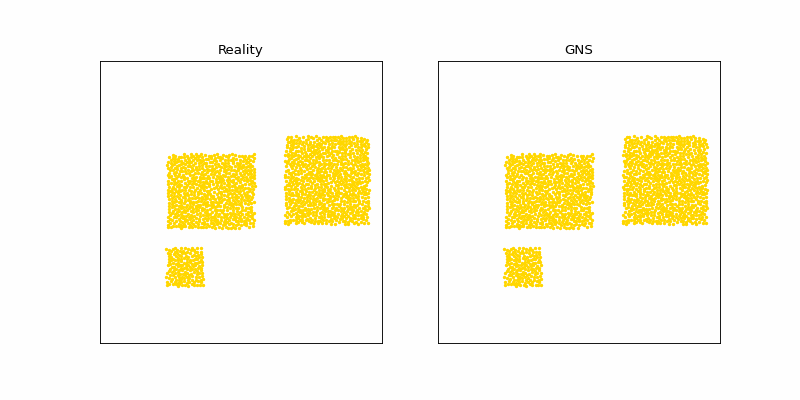Our research on Scientific Machine Learning (SciML) and differentiable programming focuses on discovering new physics and developing fast algorithms to accelerate numerical simulations.
Open Source Code implementations of SciML
Graph Network Simulator (GNS)
Graph Network-based Simulator (GNS) is a framework for developing generalizable, efficient, and accurate machine learning (ML)-based surrogate models for particulate and fluid systems using Graph Neural Networks (GNNs). GNS code is a viable surrogate for numerical methods such as Material Point Method, Smooth Particle Hydrodynamics and Computational Fluid dynamics. GNS exploits distributed data parallelism to achieve fast multi-GPU training. The GNS code can handle complex boundary conditions and multi-material interactions.
Differentiable MPM (DiffMPM)
DiffMPM (Differentiable Material Point Method) is an innovative approach that brings differentiability to the Material Point Method (MPM). By enabling gradients to flow through MPM simulations, DiffMPM unlocks a new frontier in physics-based optimization and machine learning tasks, bridging the gap between computational mechanics and deep learning paradigms. Leveraging the core principles of MPM, which provides a robust mechanism for simulating complex materials and large-deformation problems, DiffMPM enhances this capability by allowing for end-to-end optimization of simulation parameters, thereby opening doors to novel applications in additive manufacturing, robotics, and design. Our research group delves deep into exploring the potential of DiffMPM and its implications in both theoretical advancements and practical applications.
Simulations

Videos
X-AI and Machine Learning, 2022 SimCenter-DesignSafe AI workshop
Team
Publications
SetONet: A Deep Set-based Operator Network for Solving PDEs with permutation invariant variable input sampling
Tretiakov, S., Li, X., Kumar, K.;
Towards scientific machine learning for granular material simulations – challenges and opportunities
Fransen, M., Fürst, A., Tunuguntla, D., Wilke, D.N., Alkin, B., Barreto, D., Brandstetter, J., Cabrera, M.A., Fan, X., Guo, M., Kieskamp, B., Kumar, K., Morrissey, J., Nuttall, J., Ooi, J., Orozco, L., Papanicolopulos, S.-A., Qu, T., Schott, D., Shuku, T., Sun, W.C., Weinhart, T., Ye, D., Cheng, H.;
Machine Learning Aided Modeling of Granular Materials: A Review
Wang, M., Kumar, K., Feng, Y. T., Qu, T., Wang, M.;
Inverse analysis of granular flows using differentiable graph neural network simulator
Choi, Y.J, Kumar, K.;
Graph Neural Network-based surrogate model for granular flows
Choi, Y.J, Kumar, K.;
Computers and Geotechnics
Three-dimensional granular flow simulation using graph neural network-based learned simulator
Choi, Y.J, Kumar, K.;
Accelerating particulate and fluid simulations with graph neural networks for solving forward and inverse problems
Kumar, K., Choi, Y.J.;
Differentiable programming for inverse estimation of soil permeability and design of duct banks
Vajapeyajula, A., Kumar, K.;
An inverse analysis of fluid flow through granular media using differentiable lattice Boltzmann method
Wang, Q., Kumar, K.;
Enabling knowledge discovery in natural hazard engineering datasets on DesignSafe
Mehta, C., Kumar, K.;
Geotechnical Parrot Tales (GPT): Harnessing Large Language Models in geotechnical engineering
Kumar, K.;
GNS: A generalizable Graph Neural Network-based simulator for particulate and fluid modeling
Kumar, K., Vantassel, J.;
Using explainability to design physics-aware CNNs for solving subsurface inverse problems
Crocker, J., Kumar, K., Cox, B.;
Evaluation of particle motions in stabilized specimens of transparent sand using deep learning segmentation
Marx, D., Kumar, K., Zornberg, J.;
A frequency-velocity CNN for developing near-surface 2D Vs images from linear-array, active-source wavefield measurements
Abbas, A, Vantassel, J., Cox, B. R., Kumar, J., Crocker, J;
Minority Report: A graph network oracle for in situ visualization
Kumar, K., Navratil, P., Solis, A., Vantassel, J;
A machine learning approach to predicting pore pressure response in liquefiable sands under cyclic loading
Choi, Y., Kumar, K.;
Using Convolutional Neural Networks (CNN) to develop starting models for 2D full waveform inversion
Vantassel, J. P.;
Kumar, K.;
Cox, B. R.;
Geophysics
